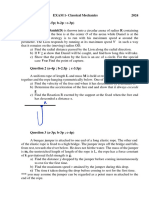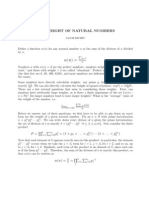Monkeys and Bananas
Monkeys and Bananas
Uploaded by
Jacob RicheyCopyright:
Available Formats
Monkeys and Bananas
Monkeys and Bananas
Uploaded by
Jacob RicheyCopyright
Available Formats
Share this document
Did you find this document useful?
Is this content inappropriate?
Copyright:
Available Formats
Monkeys and Bananas
Monkeys and Bananas
Uploaded by
Jacob RicheyCopyright:
Available Formats
Monkeys and Ladders
It is well known that monkeys like bananas. Suppose we have some (finite number of) ladders, and as many monkeys. Each monkey is assigned a ladder, and at the top of each ladder there is a banana. Between the ladders, we connect some (finitely many) ropes: each rope connects two ladders (though a rope could connect a ladder to itself). Each monkey begins climbing up his ladder, traversing a rope whenever he reaches one, and continuing to climb on the ladder he ends up on. We wont think of two ropes connecting at the same point: that is, monkeys never have to choose which path to take. The question is: does each monkey get a banana? Below is an example of how this might go:
B C A E
B E A C D
Before we prove that yes, each monkey does his own banana, we need to prove that something doesnt go wrong: that each monkey reaches the top of some ladder, i.e. doesnt get stuck in some infinite loop of ropes and ladders. Lemma 1: Each monkey reaches the top of some ladder. Proof: Suppose there were some monkey that didnt reach the top of any ladder. That monkey must have traversed infinitely many ropes, since if he traversed only finitely many ropes, then after traversing the last rope he would have climbed to the top of the ladder he ended up on. Since there are only finitely many ropes, he must have crossed some rope in the same direction infinitely many times (else only finitely many times in each direction finitely many times total). Call this rope X (as in the diagram below), the ladder that our monkey met rope X on infinitely many times on ladder 1 (letting the direction he crossed it in infinitely many times be from right to left WLOG). To get back to rope X after the first time, some rope must have taken us to some point below rope Xon ladder 1: call this rope Y . In partiular, rope Y should be the rope he crossed just before crossing rope X, i.e., there are no other ropes coming from ladder 1 between ropes Y and X. (Note that ropes X and Y could be the same rope: this isnt the case in the diagram, but our argument still works.) Now, a question arises: how did we get to rope X the very first time? It cant have been from some point below y, since then we would have crossed rope Y before crossing X. And it couldnt have been another rope that brought us there, since there are no other ropes between x and y. This is a contradiction: therefore, no such ropes exist, and each monkey reaches the top of some ladder.
times on ladder 1 (letting the direction he crossed it in infinitely many times be from right to left WLOG). To get back to rope X after the first time, some rope must have taken us to some point below rope Xon ladder 1: call this rope Y . In partiular, rope Y should be the rope he crossed just before crossing rope X, i.e., there are no other ropes Monkeys and Bananas.nb coming from ladder 1 between ropes Y and X. (Note that ropes X and Y could be the same rope: this isnt the case in the diagram, but our argument still works.) Now, a question arises: how did we get to rope X the very first time? It cant have been from some point below y, since then we would have crossed rope Y before crossing X. And it couldnt have been another rope that brought us there, since there are no other ropes between x and y. This is a contradiction: therefore, no such ropes exist, and each monkey reaches the top of some ladder.
x ........... X
y Y
What this lemma actually proves is that no monkey traverses any direction of any ladder more than once. To prove the theorem, we need only make one final observation: that two monkeys cannot end up at the same banana. Theorem: Each monkey gets a banana. Proof: Suppose two monkeys reached the same banana. Then we may trace the path from that banana backwards, since we use the same rules for going down this system of ladders and ropes as we do for going up: whenever you reach a rope, cross it, else keep climbing down. By lemma 1, we must end up at the bottom of the system eventually, and the path is unique there is a ladder we end up at the bottom of. But no two monkeys started at the bottom of the same ladder, a contradiction. Therefore, no two monkeys reach the same banana. We may now prove the theorem directly: for each monkey climbs to the top of some ladder by lemma 1, and it is not the same ladder as any other monkey. That is, each monkey gets a banana for himself.
You might also like
- Rotating ShipDocument7 pagesRotating ShipMark Eichenlaub100% (1)
- The Infinite Tortoise: The Curious Thought Experiments of History's Great ThinkersFrom EverandThe Infinite Tortoise: The Curious Thought Experiments of History's Great ThinkersNo ratings yet
- Google PROFESSIONAL-CLOUD-ARCHITECT Goog PDFDocument5 pagesGoogle PROFESSIONAL-CLOUD-ARCHITECT Goog PDFAbhishek Mathur0% (1)
- Introduction To CriminologyDocument123 pagesIntroduction To CriminologyJustine Tab100% (7)
- Mathematical Mysteries: Zeno's Paradoxes: by Rachel ThomasDocument3 pagesMathematical Mysteries: Zeno's Paradoxes: by Rachel ThomasNur Farah HanaNo ratings yet
- SlopeDocument3 pagesSlopeDiana Rose Valencia FortitNo ratings yet
- Waves Penurunan RumusDocument3 pagesWaves Penurunan RumusRizkaNo ratings yet
- Mummy Madness: InputDocument2 pagesMummy Madness: InputHello misterNo ratings yet
- DT PowerscalingDocument6 pagesDT PowerscalingJOAO VITOR DOS SANTOS SILVANo ratings yet
- Zenos Paradox of MotionDocument3 pagesZenos Paradox of Motionabubakar ibrahimNo ratings yet
- ConwayDocument10 pagesConwayapi-3835172No ratings yet
- Conversion PDFDocument6 pagesConversion PDFVillarojo Engco LenylynNo ratings yet
- Conway's Game of Life: Melissa GymrekDocument50 pagesConway's Game of Life: Melissa GymrekbavytifNo ratings yet
- Text Report On Zeno's Problem From The Point of View of Differential CalculusDocument3 pagesText Report On Zeno's Problem From The Point of View of Differential CalculusButmin BloomNo ratings yet
- AchillesDocument4 pagesAchillestarikjary1976No ratings yet
- Euler Paths and CircuitsDocument29 pagesEuler Paths and Circuitsfalconihla6191No ratings yet
- Graph Puzzles SolutionsDocument4 pagesGraph Puzzles SolutionsMohamed AlansaryNo ratings yet
- MOA L40 Escalator and Staircase ProblemsDocument12 pagesMOA L40 Escalator and Staircase Problems643627No ratings yet
- Lecture 3 (Sep 5)Document4 pagesLecture 3 (Sep 5)hustleresearch081No ratings yet
- Cemtl Graph Euler HamiltonDocument3 pagesCemtl Graph Euler HamiltonJKNo ratings yet
- W13 Euler Paths and Circuits PDFDocument5 pagesW13 Euler Paths and Circuits PDFJohn Kenneth MantesNo ratings yet
- Pumping Lemma For Regular Languages: Sipser Pages 77 - 82Document21 pagesPumping Lemma For Regular Languages: Sipser Pages 77 - 82John JohnstonNo ratings yet
- Kyle Parker-Millea Kenny Black Brigette Eckert Carly WilsonDocument41 pagesKyle Parker-Millea Kenny Black Brigette Eckert Carly WilsonGaurav giriNo ratings yet
- Chap16 Physics Unit 1 SMH-WAVES I - WAVES IIDocument19 pagesChap16 Physics Unit 1 SMH-WAVES I - WAVES IICarsonRDNo ratings yet
- Greedy Algorithms StandardDocument137 pagesGreedy Algorithms StandardNikhilNo ratings yet
- Intuitive Understanding of Sine Waves - BetterExplainedDocument24 pagesIntuitive Understanding of Sine Waves - BetterExplainedavnishNo ratings yet
- Betrayal at House On Hill ErrataDocument12 pagesBetrayal at House On Hill ErrataCaleb PostNo ratings yet
- Hive Monarch-FullDocument45 pagesHive Monarch-FullRitZan 23No ratings yet
- Guangzhou Boban PDFDocument82 pagesGuangzhou Boban PDFĐạt NguyễnNo ratings yet
- Portal 2 Lesson Plan Portal Bouncing OscillationsDocument4 pagesPortal 2 Lesson Plan Portal Bouncing OscillationsFilip VaněkNo ratings yet
- Is The Fourth Dimension TimeDocument5 pagesIs The Fourth Dimension TimejonNo ratings yet
- IntroductionToRobotics Lecture06 PDFDocument12 pagesIntroductionToRobotics Lecture06 PDFY.EbadiNo ratings yet
- Waves (PHYSICS)Document31 pagesWaves (PHYSICS)Ellenor ErasanNo ratings yet
- WavesDocument55 pagesWavesRana BustamiNo ratings yet
- Chap 6Document59 pagesChap 6arvapallNo ratings yet
- Chapter Seven: The Pendulum and Phase-Plane PlotsDocument15 pagesChapter Seven: The Pendulum and Phase-Plane PlotsJosé Del Angel Sánchez BurgosNo ratings yet
- Horizontal and Slant AsymptotesDocument4 pagesHorizontal and Slant AsymptotesAnonymous NL4u0dtVbcNo ratings yet
- Hive Hive: Goal: GoalDocument2 pagesHive Hive: Goal: GoalAnonymous XZgbk44CjVNo ratings yet
- Tigers and Goats Board GameDocument3 pagesTigers and Goats Board GameSoundararajan SeeranganNo ratings yet
- A New Algorithm For Knight's ToursDocument30 pagesA New Algorithm For Knight's ToursnabilshfNo ratings yet
- 01 - Introduction Lines and Triangles Problem - enDocument3 pages01 - Introduction Lines and Triangles Problem - enparmodmagotra6391No ratings yet
- 44 Multiplicity of EigenvaluesDocument2 pages44 Multiplicity of EigenvaluesHong Chul NamNo ratings yet
- GoodphysicsbadphysicsDocument4 pagesGoodphysicsbadphysicsapi-313214812No ratings yet
- Mit18 06S10 L24Document14 pagesMit18 06S10 L24ravi04042024No ratings yet
- 075 DimensionDocument1 page075 DimensionNeoHoodaNo ratings yet
- InputDocument1 pageInputJubaida SaimaNo ratings yet
- GREAT Prepositions of MovementDocument3 pagesGREAT Prepositions of MovementANALI ANITA BASURCO SALDIVAR100% (1)
- Variant Pieces Rules v1.2Document15 pagesVariant Pieces Rules v1.2Guilherme SaturninoNo ratings yet
- Two ProblemsDocument11 pagesTwo ProblemsArnab DattaNo ratings yet
- 1st Module - Class 1Document11 pages1st Module - Class 1josephsebastian6812No ratings yet
- Cut-Scene.: Chapter 1 - Mediterranean SeaDocument9 pagesCut-Scene.: Chapter 1 - Mediterranean Seacorrnelia1No ratings yet
- P151 Discussion Questions-5-MomentumDocument2 pagesP151 Discussion Questions-5-Momentumn9sjpmhdkcNo ratings yet
- 1st-Exam-Mechanics 240304 183647Document1 page1st-Exam-Mechanics 240304 183647salievtemirkhanNo ratings yet
- 1st-Exam-Mechanics 240305 164057Document14 pages1st-Exam-Mechanics 240305 164057salievtemirkhanNo ratings yet
- 1st Exam Mechanics - SolutionsDocument19 pages1st Exam Mechanics - SolutionssalievtemirkhanNo ratings yet
- WavesDocument18 pagesWavesCenzhed CamarinesNo ratings yet
- VaziraniDocument100 pagesVaziranibobbyNo ratings yet
- Catch-Up Friday Week 3Document16 pagesCatch-Up Friday Week 3ynaquibuyenNo ratings yet
- Sculpture Diaries WorksheetDocument9 pagesSculpture Diaries WorksheetcarlaraguseoNo ratings yet
- Hive Bugs Expansions 2Document4 pagesHive Bugs Expansions 2RitZan 23No ratings yet
- The Quantum Zeno EffectDocument10 pagesThe Quantum Zeno Effectrgkelly62No ratings yet
- Monochromatic ComponentsDocument5 pagesMonochromatic ComponentsJacob RicheyNo ratings yet
- Weight of Natural NumbersDocument6 pagesWeight of Natural NumbersJacob RicheyNo ratings yet
- Counting Clusters On A Finite GridDocument18 pagesCounting Clusters On A Finite GridJacob RicheyNo ratings yet
- Bases For The Natural NumbersDocument4 pagesBases For The Natural NumbersJacob RicheyNo ratings yet
- Needles in Haystacks, Oceans and MoreDocument9 pagesNeedles in Haystacks, Oceans and MoreJacob RicheyNo ratings yet
- The Iron Bars Problem: Jacob RicheyDocument4 pagesThe Iron Bars Problem: Jacob RicheyJacob RicheyNo ratings yet
- Sum ConstructionsDocument6 pagesSum ConstructionsJacob RicheyNo ratings yet
- Needle Experiments Part 1Document4 pagesNeedle Experiments Part 1Jacob RicheyNo ratings yet
- Assorted ProblemsDocument6 pagesAssorted ProblemsJacob RicheyNo ratings yet
- Expected Value of The Greatest of A Set of RealsDocument4 pagesExpected Value of The Greatest of A Set of RealsJacob RicheyNo ratings yet
- Magic TricksDocument5 pagesMagic TricksJacob RicheyNo ratings yet
- Polynomial SeriesDocument3 pagesPolynomial SeriesJacob RicheyNo ratings yet
- Two Cute ProofsDocument4 pagesTwo Cute ProofsJacob RicheyNo ratings yet
- Cosine ApproximationDocument8 pagesCosine ApproximationJacob RicheyNo ratings yet
- Mathematics Magazine Problem 1822Document3 pagesMathematics Magazine Problem 1822Jacob RicheyNo ratings yet
- Nested Radical RecursionsDocument4 pagesNested Radical RecursionsJacob RicheyNo ratings yet
- SK Islamic Studies Curriculum FrameworkDocument23 pagesSK Islamic Studies Curriculum FrameworkNurbaiti HanaffiahNo ratings yet
- An Interpretation of The Halliwell ManuscriptDocument4 pagesAn Interpretation of The Halliwell ManuscriptMashae Mcewen100% (1)
- Call Center Job Duties and ResponsibilitiesDocument2 pagesCall Center Job Duties and ResponsibilitiesOlaya alghareniNo ratings yet
- Legal Ethics - Valencia vs. Atty. AntiniwDocument9 pagesLegal Ethics - Valencia vs. Atty. AntiniwQuerllonNo ratings yet
- DC (SC) 163786/2 © UCLES 2019: (Turn OverDocument4 pagesDC (SC) 163786/2 © UCLES 2019: (Turn OverKaashvi DewanNo ratings yet
- 1 s2.0 S1991790221001045 MainDocument10 pages1 s2.0 S1991790221001045 MainAazariNo ratings yet
- ACO - 2023 Season - BrochureDocument31 pagesACO - 2023 Season - BrochureWeisslenny0No ratings yet
- Dead Weight Calibrator I&C Exp 2Document7 pagesDead Weight Calibrator I&C Exp 2tabish miraj0% (1)
- Rumus EnglishDocument19 pagesRumus EnglishFazriarni Asri HayyuNo ratings yet
- NSTP ReviewerDocument5 pagesNSTP ReviewerJaspher BalanonNo ratings yet
- RomantismeDocument7 pagesRomantismeJung MonNo ratings yet
- SAP Introduction To Treasury ApplicationsDocument28 pagesSAP Introduction To Treasury Applicationsfaxmolder100% (1)
- Mnemonics - AnatomyDocument3 pagesMnemonics - Anatomymastac741No ratings yet
- FIFA President Claims Football Began in China: Warm-UpDocument5 pagesFIFA President Claims Football Began in China: Warm-UpJornie Marie W. LagunaNo ratings yet
- Calendar 2010Document1 pageCalendar 2010krajiv68No ratings yet
- Due Process of LawDocument5 pagesDue Process of LawChito SpeedyGonzales SebiosNo ratings yet
- Talk Nerdy To MeDocument3 pagesTalk Nerdy To Mejoshua eligioNo ratings yet
- The Effectiveness of Mass Media Campaigns: Youth Substance AbuseDocument30 pagesThe Effectiveness of Mass Media Campaigns: Youth Substance AbuseKarina YesikaNo ratings yet
- Excursion Risk Management Plan ProformaDocument4 pagesExcursion Risk Management Plan ProformaPrachi GarudNo ratings yet
- Classroom Instructional Delivery Alignment Map For Grades For K-12Document2 pagesClassroom Instructional Delivery Alignment Map For Grades For K-12Queenie GamboaNo ratings yet
- Criteria Exceeded Expectations 4 Meets Expectations 3 Missed Expectations 2 Did Not Meet Expectations 1 Following DirectionsDocument2 pagesCriteria Exceeded Expectations 4 Meets Expectations 3 Missed Expectations 2 Did Not Meet Expectations 1 Following Directionsrazee_No ratings yet
- Heirs of RubenDocument1 pageHeirs of RubenJanine IsmaelNo ratings yet
- Financial Innovation in India-Boon or Bane by Raghav Goenka - 11bsp0341-Class of Sec. AnalysisDocument2 pagesFinancial Innovation in India-Boon or Bane by Raghav Goenka - 11bsp0341-Class of Sec. AnalysisRaghav GoenkaNo ratings yet
- Enzymes Used in RDT Corrected Version EditedDocument43 pagesEnzymes Used in RDT Corrected Version EditedYuppie RajNo ratings yet
- Configuration IPv4 MVPNDocument28 pagesConfiguration IPv4 MVPNHieuNBNo ratings yet
- Pakistani English NovelistsDocument4 pagesPakistani English Novelistsbc070400339100% (2)
- 5A, 28V Input, Step Down Swift™ DC/DC Converter With Eco-Mode™Document27 pages5A, 28V Input, Step Down Swift™ DC/DC Converter With Eco-Mode™thunderer2014No ratings yet
- Psychological Mechanism of The Speech ProcessDocument14 pagesPsychological Mechanism of The Speech ProcessMariia BilovodNo ratings yet









































































































